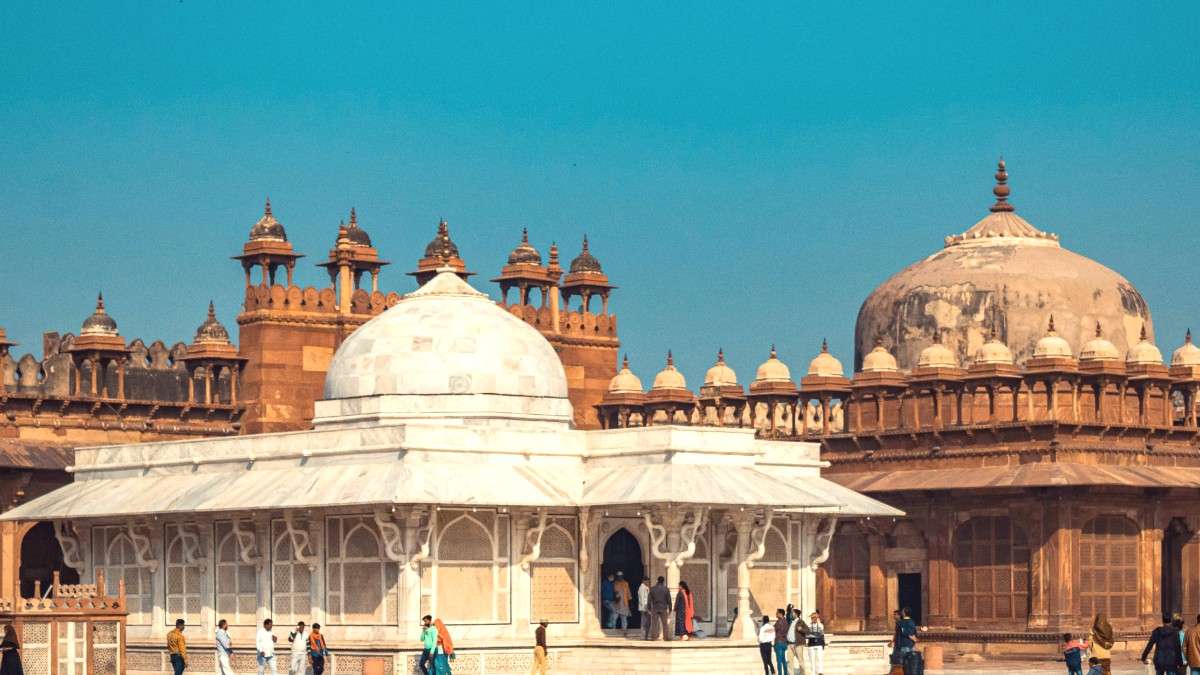
Uttar Pradesh, India
India’s climate generally has three distinct seasons: summer, monsoon, and winter, each bringing different conditions for visitors.
Each season presents unique benefits and challenges for your journey.
Peak Comfort
Most comfortable weather. Clear skies, moderate temperatures. Optimal for extensive outdoor exploration and photography.
Larger tourist crowds. Higher demand for accommodations and services. Booking well in advance is advisable.
Transitionary Travel
Fewer crowds than high season. Reasonable weather, especially in March and October. Better deals on flights and accommodation often available.
Temperatures rise significantly in March and April. High humidity persists in September and early October from lingering monsoon.
Budget-Friendly
Fewest tourists. Substantial discounts on accommodation and services often available.
Extreme heat in May and June. Heavy monsoon rains from July to August, leading to travel disruptions. Outdoor activities less appealing.
Summers in Fatehpur Sikri bring intense heat. Visitors during May and June must take care to avoid sunstroke and dehydration. Drink ample water, wear lightweight, loose clothing, and find shade frequently. Plan your sightseeing for early mornings or late afternoons.
Heavy rainfall during July, August, and September can cause localized flooding in nearby areas and might delay ground transportation. Pathways within the Fatehpur Sikri complex can become slippery when wet, so wear proper footwear. In December and January, notably dense fog might occur in North India. This might limit visibility and cause delays for trains, flights, and road travel, especially early in the mornings. Plan your travel with extra time during these months.
October to March offers the best conditions. Early mornings during this period are notably good, allowing for unhurried exploration and detailed photography.
Visit during shoulder or low season for fewer crowds, but be ready for varying weather.
Low season (May-August) often presents the best prices for flights and accommodation.
Early mornings, even in hot seasons, are cooler and offer a more pleasant experience.
Travel during major Indian holidays for a cultural experience, though expect more crowds.
India uses a system for international visitors, which changes based on nationality and trip purpose. Review these requirements well before your departure.
The e-Visa is a straightforward option for tourism to India, available to many nationalities. Other visa types are available based on your travel needs.
For assistance with visa applications, consider IVisa or VisaHQ.
India presents experiences across a wide budget range, making it open to diverse travel preferences.
These are average daily costs, based on staying in Agra, which is the recommended base due to limited options in Fatehpur Sikri town.
Consider staying in Agra for more accommodation and dining choices, often at better value. Use local buses or shared taxis between Agra and Fatehpur Sikri. Embrace local street food for authentic and inexpensive meals. Bargain politely in local markets. Carry small denomination notes. Use a Reusable water bottle to refill from purified sources.
This section covers health precautions, safety steps, and emergency details.
Consult a travel doctor or clinic at least 4-6 weeks before your trip to discuss vaccination needs. Yellow Fever vaccination is required for travelers from or transiting through Yellow Fever risk countries.
Recommended vaccinations for India include Hepatitis A & B, Typhoid, Tetanus, Diphtheria, Pertussis (Tdap), Measles, Mumps, Rubella (MMR), Polio, Rabies (if extensive animal contact), and Japanese Encephalitis (if extended rural stay during monsoon).
Basic medical facilities and pharmacies are available in Fatehpur Sikri town. For serious medical issues, immediate travel to Agra (approximately 40 km / 25 miles away) is necessary. Agra has many hospitals and clinics, including private hospitals with modern facilities and English-speaking staff.
Agra offers modern private hospitals for comprehensive medical care.
Emergency Numbers: Police: 100, Ambulance: 102, Fire: 101, National Emergency: 112.
Always prioritize safe drinking water. Consume only bottled water with an intact seal, or use a reliable purification method. Avoid tap water, even for brushing teeth. Be cautious with food choices. Eat at reputable establishments that appear clean and have a high customer turnover.
Insist on bottled or purified water. Avoid ice unless its source is clear.
Prefer hot, freshly cooked dishes. Avoid raw salads and unpeeled fruits from unknown sources.
Fatehpur Sikri is generally safe, especially within the historical complex. Petty theft (pickpocketing) can occur in crowded areas. Aggressive touts and unofficial guides are sometimes present. Scams, like inflated prices, are possible. Trust your instincts.
Stay aware of your surroundings. Keep valuables secure and out of sight.
Avoid walking alone in dimly lit or isolated areas after dark.
| Category | Coverage & Information | Affiliate Resources |
|---|---|---|
| Travel Insurance | Highly recommended for medical emergencies, trip cancellation, lost luggage, and personal liability. Compare policies carefully. | World Nomads, SafetyWing, Insubuy |
| Emergency Contacts (India) | Police: 100, Ambulance: 102, Fire: 101, All-in-one Emergency: 112, Tourist Helpline: 1800-11-1363. | AirHelp (for flight compensation issues) |
| Personal Contacts | Keep details for your country's embassy/consulate in New Delhi, family/friends back home, and your local tour operator/hotel. |